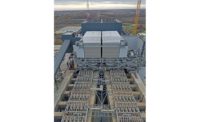ENR Midwest’s 2019 Best Projects
Iowa Pork Processing Plant Uses Captured Methane as Fuel

The $303-million, 650,000-sq-ft pork processing plant contains more than five miles of conveyor belts and freezers, with 20,000 sq ft of refrigerated space. Its cut floor was designed to process about 600 million lb of pork annually.
Photos by Mark Ballogg, Ballogg Photography

The belly trimmers use a 3D laser imaging system to determine the optimal cuts for each carcass, and automated water jets make those cuts. The specialty cuts are made by workers.




Prestage Foods of Iowa Pork Processing Plant
Eagle Grove, Iowa
BEST PROJECT
Owner: Prestage Foods of Iowa
Lead Design Firm/Design-Build Contractor: Epstein
Prestage Farms has grown from a four-person family business in 1983 into a company that employs more than 2,700, contracts with more than 470 farms and produces more than 1.4 billion lb of pork and turkey each year.
The latest piece of the company’s growth is a $303-million, 650,000-sq-ft pork processing plant for the company’s Prestage Foods of Iowa division. Located on a 160-acre site in Eagle Grove, Iowa, the plant, designed and built by Epstein, broke ground in spring 2017 and faced several challenges from the beginning. Bedrock issues caused the time to install the first of two 2,000-ft-deep wells to more than double, and heavy rain and Northern Iowa winter weather created challenges as well. Despite that, the facility opened its doors on time in March 2019.
The 100,000-sq-ft cut floor was designed to process about 600 million lb of pork annually. The plant contains more than five miles of conveyor belts and freezers, with 20,000 sq ft of refrigerated space. The process area is temperature-controlled throughout to meet food safety and quality requirements while saving energy wherever possible.
Automation is a cornerstone of the plant’s production process. From the time a carcass enters the plant until it leaves as either finished product, bulk product or inedible material for rendering, it’s moved on either an overhead rail system or a conveyor, eliminating the need for workers to lift carcasses on and off. The belly trimmers use a 3D laser imaging system to determine the optimal cuts for each carcass, and automated water jets make those cuts. The specialty cuts are made by workers.
In addition to automation, Epstein and Prestage had environmental goals to meet. The complex includes a rendering facility and wastewater treatment facility. The onsite rendering facility takes the inedible portions of hog carcasses and renders them into other non-edible products. Because the material doesn’t have to be shipped off site before rendering, fewer trucks come in and out of the facility compared with processing plants that don’t have onsite rendering.
The rendering process produces hydrogen sulfide, which is toxic and odorous at low concentrations. A regenerative thermal oxidation and wet scrubbing system captures emissions at process points where hydrogen sulfide is produced. The emissions are passed through a regenerative thermal oxidizer, which thermally reduces hydrogen sulfide molecules to non-odorous sulfur oxides. In addition to capturing hydrogen sulfide at specific points in the plant, scrubbers were installed on all exhaust vents in the rendering facility to help eliminate odors.
The site also includes a 6,000-head holding barn, which raised concerns about how odors from the plant would affect the local community. Epstein designed a bio-filtration system that receives 100% of barn exhaust and passes it through a filter media. Bacteria in the media reduces the odor-causing elements.
The wastewater lagoons are covered to eliminate fumes, but the covers add another environmental benefit. The covered lagoons allow capture of methane created during the treatment process. The methane is used as an energy source for boilers throughout the plant, decreasing the amount of natural gas needed to run them.
Back to "35 Best Projects Showcase Midwest Design, Construction Innovation"





